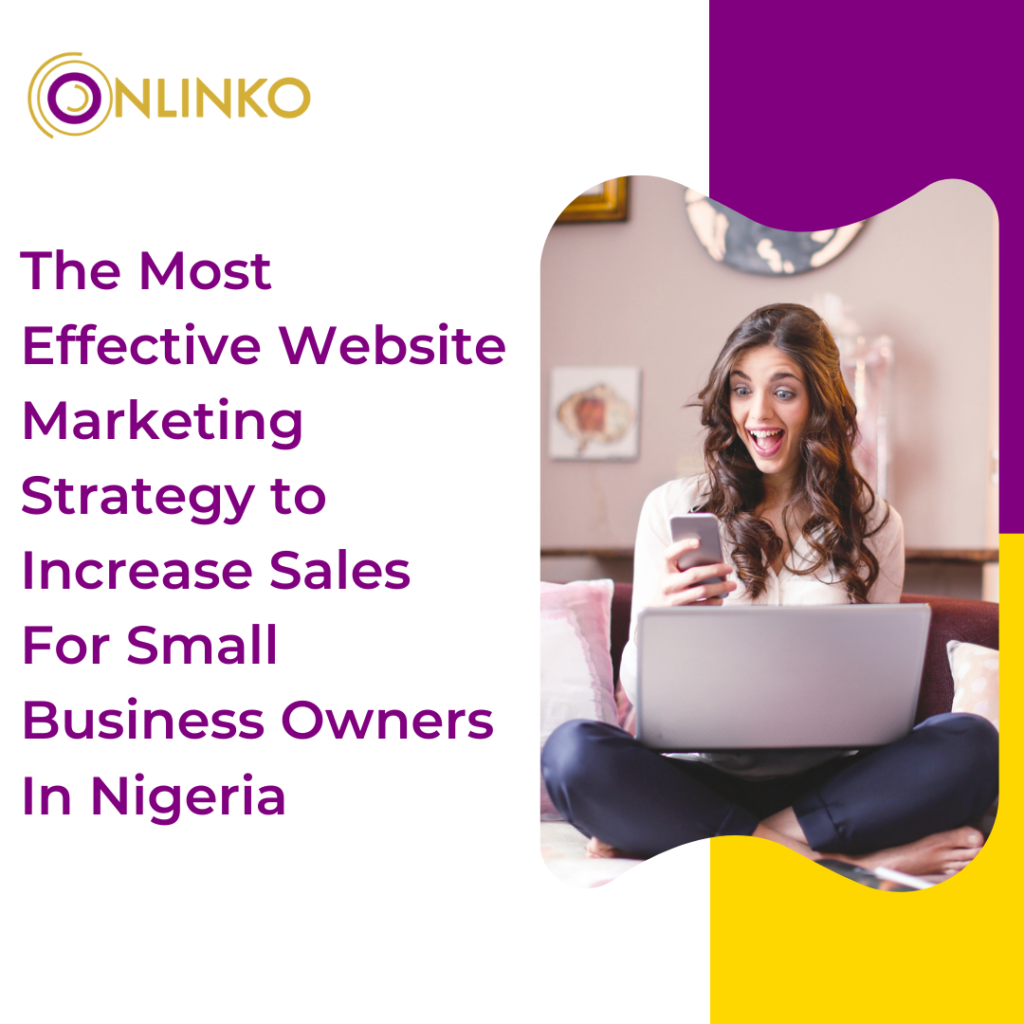Effective website marketing strategies can significantly boost sales for small business owners in Nigeria or any other location.
According to Business Insider, 40% of consumers are heading to search engines to get more information as they make their purchasing decisions.
This should come as no surprise given that Google gets over 100 billion searches each month.
What does this mean for your business?
If you don’t already have an integrated website marketing strategy in place that includes an effective website and SEO strategy.
Below, we’ve created a step-by-step guide to creating an effective website marketing strategy for business in Nigeria.
By following the process below.
You’ll be on your way to developing an integrated digital marketing strategy for attracting, engaging, and converting more leads over time.
1. Conduct A Website Analysis.
The first step to creating an effective website marketing strategy is to audit your current website.
By conducting a website analysis of your current site design and content.
You can better understand what you’re doing well and where there may be opportunities for improvement.

When it comes to site design, you will want to consider the user experience. Your website should be easy to read and navigate.
Review your navigation bar and site map to ensure that visitors can easily find and access the pages they are looking for.
Make sure that font sizes and colors are easy to read and all images can be viewed, especially from smaller device screens.
And before you go live with your new website design, test it out first on all devices.
Also, check your website’s pages using different browsers.
You can’t expect everyone to use the Chrome browser just because you do. Try it out and see if it delivers the same functionalities across all browsers.
You see, aside from the content, user experience is one of the key factors for ranking on search engines.
When analyzing your site, you should also look at load times.
Slow load times will not only impact the user experience but can also hurt you when it comes to SEO.
To reduce load times, make sure that any images or video that you use on your site is condensed so it does not impact the time it takes for each page to load.
Another thing to look for during your website analysis is whether your site is mobile responsive.
Mobile-friendly websites are no longer optional for businesses that want to remain competitive in the digital marketplace.
2. Optimize Your Website For SEO
The next step is to start thinking about your SEO strategy. A well-defined SEO plan will eventually increase your rankings and traffic from search engines.
SEO is the process of increasing your website’s visibility in search engines, and it consists of several steps:
Technical SEO – Making sure that your website is free of crawl errors and other issues that might keep search engines from indexing your website properly.
On-Page SEO – Make your webpages SEO-friendly and your content easily read by search engine crawlers.
SEO Content – Writing content that satisfies the user’s intent.
Off-Page SEO – Promoting your website to get high-quality links from other websites.
Local SEO – Optimizing your website for location-aware searches and for getting more clients to your brick-and-mortar store.
Besides the above standard SEO practices, you should also optimize your website for modern SEO, like adding schema markup and optimizing your content for rich snippets.
3. Optimize Your Website For Social Media
The next step is to optimize your website for social media. This is not the same as social media marketing (we’ll talk about this in step 5), but it has to do with the following:
- Having visual elements (images, video) on your website that can be shared on social media networks.
- Adding social media sharing buttons on the pages you want to be shared on social networks.
- Making sure that when a user clicks the share button (or shares your URL directly), the generated snippet is well-formatted.
- Adding the necessary open graph meta tags and using image sizes and formats supported by all major networks is recommended.
Many webmasters skip this step, and it’s a mistake that can negatively affect your social media promotion efforts.
While it looks like it’s more technical and not marketing-related, it does play an important role. If your website does not allow users to share your content properly, don’t expect any social media exposure.
4. Create A Content Marketing Plan
The next step in your website marketing plan is to design a content marketing strategy.
When you promote a website online, you essentially promote your website’s content, which is why it is referred to as content marketing.
The main purpose of content marketing is to help you create the right type of content to attract new users to your website and keep them engaged.
To create a good strategy, you first need to:
- Do your keyword research and determine which SEO keywords to target with your content.
- Perform competitor analysis and find out what is working for your competitors.
- Analyze Google search results to determine what type of content Google wants for your target keywords (length of content, images/video, etc.).
Once you have a list of topics/keywords, you should create a content marketing calendar to specify when each piece of content will be published, who will write it, and how it will be promoted after publication.
Companies that manage to have an ongoing content marketing campaign have more chances of succeeding online than companies that publish content occasionally without a plan.
5. Amplify With Email Marketing
After you’ve started working to create more content assets and build your social media following.
You can continue to amplify your website marketing strategy with email marketing.
Email marketing enables you to get the word out about your new products and promotions while also driving traffic back to your website.
Before you start sending marketing emails, you’ll need to work on building your email list.
There are a few different ways you can do this. You can start with the email addresses of your current customers.
Then, work to build on your list by capturing new contact information from lead forms.
One way that you can work to collect email addresses from new leads is by creating a valuable incentive.
An incentive that you might provide is a compelling content offer such as an e-book, checklist, or special guide that will help your leads better understand their challenges.
You can create a landing page with a lead form that collects visitor email addresses in exchange for a free download of the content offer.
You can also add an email opt-in form to your website.
Whether you use a header bar, a pop-up, or a sidebar, you can ask your site visitors to sign up for your email list to stay up-to-date with the latest updates.
And, content from your business.
You can also place CTAs in some of your blogs or other content, encouraging your readers to sign up for your email list for more great content.
6. Use Paid Ads To Reach More Customers
As soon as you get started with SEO and social media marketing, you’ll realize one thing. It takes time for SEO to work and to get a decent number of followers on social media organically.
This means that if you want results faster, you need to add one more ingredient to your website marketing and that is paid advertising.
With paid advertising, you can get targeted traffic fast and start making sales or conversions.
There are various advertising platforms you can use, but the most common are:
Google Ads – Target people based on the search terms they use on Google or show your ads on other Google properties (YouTube, Gmail) and websites that participate in Google AdSense.
Facebook Paid Ads – Promote your Facebook page, social media postings, or ads to people using Facebook, Instagram, or Facebook Messenger.
Both methods are very effective but you should be careful not to waste a lot of money on advertising without a return.
Better start with a low budget and measure the effectiveness of your campaigns and add more money as long as there is a positive ROI.
7. Use Remarketing To Get Users Back To Your Website
Do you know what the rule of 7 is?
It’s a rather old marketing rule which states that a potential client should see or hear an ad (or message) at least 7 times before they’ll take action to buy a product or service.
This applies to internet marketing as well. In website marketing terms, this means you need to get users to revisit your website several times before they proceed to the next step of your digital marketing funnel.
Publishing new content frequently and using social media marketing and email marketing are all great ways to achieve this, but there is one more method that is highly effective and this is remarketing.
With remarketing, you use advertising platforms (either Google Ads, Facebook, or even Twitter) to re-connect with people that visited your website at least once.
This has a number of advantages, including more targeted traffic, lower advertising costs, and higher conversion rates.
Next Step: Implementation!
Now that you know each step of the process.
It’s time to consider whether your company has the time, resources, and knowledge to effectively implement your website marketing strategy.
For most small businesses, every team member is already working at full capacity to keep business operations running smoothly.
That’s why many business owners look for outside help when implementing their website strategy.
A website marketing strategy agency can help take care of all your website needs while your team continues to focus on your core business.
The website experts at Onlinko Digital Marketing Agency know just what it takes to help you create a stunning and effective website that will attract.
And, convert more leads to help you grow your business.
In addition to website design services.
Our team is also skilled at search engine optimization tactics that will help your business rank on the search engines, increase referral traffic, and build a strong online presence.
If you’re ready to get started, we are only a phone call away! Contact us today.

